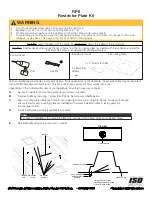
6
World Precision Instruments
WPI tests
ISO-OXY-2
and
OXELP
sensors using a 0.1M PBS test media at room
temperature. A sensor is tested at three known oxygen levels (0%, 21% and 100%).
Known concentrations are obtained as follows:
•
0% O
2
– PBS (standard test media) is purged with 100% N
2
.
•
21% O
2 –
The atmospheric concentration of O
2
is obtained using unsaturated PBS
solution exposed to air.
•
100% O
2
– PBS is purged with 100% O
2
gas.
To calibrate:
1. Fill three 20mL vials with approximately 15–18mL of 0.1M PBS buffer solution.
Label the first 0% O
2
, the second as 21% O
2
, and the third as 100% O
2.
2. To obtain 0% O
2
concentration, insert an 18-gauge needle into the 0% O
2
vial and
vigorously bubble it with N
2
gas at a constant rate for 10 minutes to displace any
atmospheric oxygen.
3. Drop a small stir bar into the vial with 0% O
2
solution and place it on a magnetic
stirring plate. Turn on the stirrer so that the bar is stirring at a moderate rate.
NOTE
: When using the stirrer, its rate should not be modified once It is set.
NOTE
: Do NOT let the sensor tip come into contact with a stir bar. It could
damage the membrane.
4. Immerse the polarized sensor in the solution and secure it in an electrode
holder such as WPI’s Pro-Guide (WPI #
47510
,
47520
,
47530
,
47540
) or a
micromanipulator. The sensor tip should be immersed about 2-3mm into the
solution. Allow the sensor to remain in the solution at least five minutes as you
view the data. Looking at the data, record the current value (nA) of the sensor at
0% O
2
in a table like the one below. The current value recorded should be taken
from the most stable (flattest) part of the recorded data.
NOTE
: For greater accuracy, readings may be taken at 30 seconds, 3 minutes
and 15 minutes for each oxygen concentration (as long as the N
2
and O
2
are
continuously bubbled into the solutions). Results can then be averaged.
[
O
2
]
Sensor Current
0%
1nA
21% (air)
48nA
100%
241nA
5. Drop a small stir bar into the vial with 21% O
2
solution and place it on the
magnetic stirring plate. Immerse the sensor in the second solution for at least five
minutes. The oxygen measurements should return to the baseline value. Record
the current value (nA) of the sensor at 21% O
2
in the table.






































